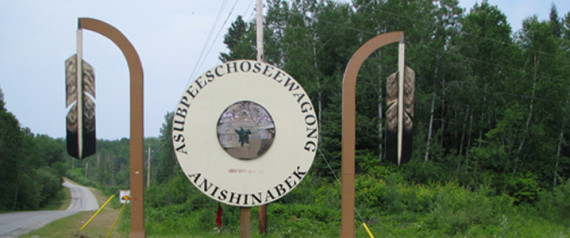Grassy Narrows First Nation Declares State Of Emergency After Years Of Unsafe Drinking Water

After almost two years of not being able to drink its water, a remote Ontario First Nation decided to issue a state of emergency Thursday.
Grassy Narrows, a small reserve about 500 kilometres northwest of Thunder Bay, has long dealt with regular cases of mercury poisoning since a local paper and chemical mill shut down in the 1960s.
But now, the very chemicals used to treat the water have flushed it with increasing levels of uranium and other possible carcinogens, band officials say.
“We’re finding out that the kind of chemicals that they put in there are very toxic and could cause cancer and other things,” councillor Bill Fobister told The Huffington Post Canada in an interview.
A “Do Not Consume” order is heading into its second year. And a boil water advisory in place for more than a year hasn’t helped either, he said.
The reserve’s water and sewer lines — on which construction began in the early ‘90s — still have not been completed. The piecemeal system has given only parts of the community access to adequate drinking water, and most Grassy Narrows residents have to rely on deliveries of bottled water.
Calls for help have fallen on deaf ears, he said, which is why the community decided to issue a direct and desperate request for help.
“If we stay quiet, they don’t say anything,” Fobister said about the federal government’s track record of helping First Nations pull out of similar situations.
According to federal law, responsibility to maintain and manage safe drinking water on reserves falls on the Government of Canada.
Possible carcinogens in the water
Documents obtained by The Huffington Post Canada show significant traces of a trio of toxic chemicals in Grassy Narrows’ drinking water supply. The results, revealed in a letter this year, prompted a provincial water manager to warn the band’s chief that the levels “may be a cause for concern.”
“These disinfectant byproducts are considered as a possible human carcinogen,” Lisa Trevisan wrote in the letter dated July 10. Health Canada was also copied on the two-page notice.

Wabigoon River in Grassy Narrows Territory. Photo: Schledewitz/redlineagency.com
A year earlier, a drinking water specialist working with the province inspected the reserve’s sewage treatment facility and deemed it inadequate and in dire need of completion.
Turbidity — the stirred sediment that makes water cloudy — was also measured to be 120 times greater than levels deemed safe for drinking.
In his report, he made several notes of missing and broken equipment.
Shock over lapsed $1 billion in funding
Despite all the health warnings raised about Grassy Narrows’ situation, the federal government has yet to make a significant push to help the reserve finish construction of its water and sewage lines and its treatment facility.
Money is an issue. Fobister said there is a funding impasse because Aboriginal Affairs and Northern Development Canada (AADNC) contends it doesn’t have enough of to fix essential services, such as supplying safe drinking water.
Earlier this summer, it was reported that AADNC had saved more than $1 billion in spending because of lapsed funding promises over five years.
Fobister said the community was “shocked” at the news that money pegged for infrastructure programs and services had been returned to the treasury instead of going to securing safe drinking water for First Nations citizens.
“They don’t seem to want to address any Anishinaabe issues,” he said.
Fobister, who has lived most of his life on the reserve, said he has been boiling his water for the past three years. Still, he’s optimistic a resolution will come into fruition by way of more government co-operation “so everyone will be safe.”
Conservative candidate Bernard Valcourt responded to news of the state of emergency by outlining some “concrete steps” the government has taken improve the quality of water in First Nations across the country.
In an email, the Madawaska-Restigouche candidate trumpeted a $320-million commitment the government made this year to fund First Nations water and wastewater treatment projects. Valcourt then acknowledged that Grassy Narrows’ situation is under review.
“Federal officials are reaching out to the First Nation and the province of Ontario to determine how they can be of further assistance,” he said.




